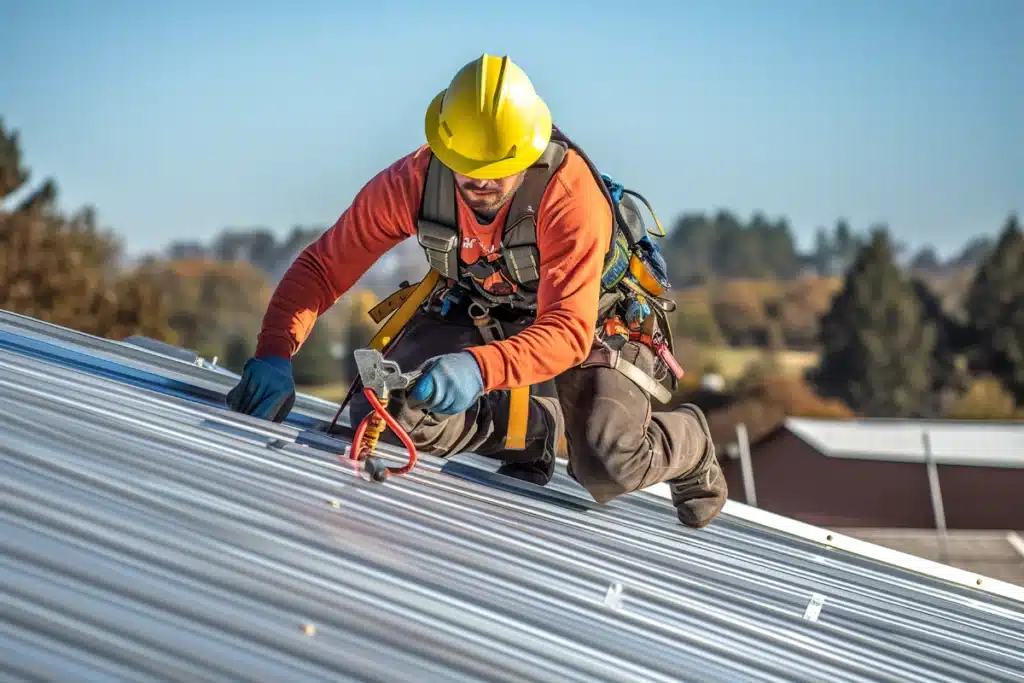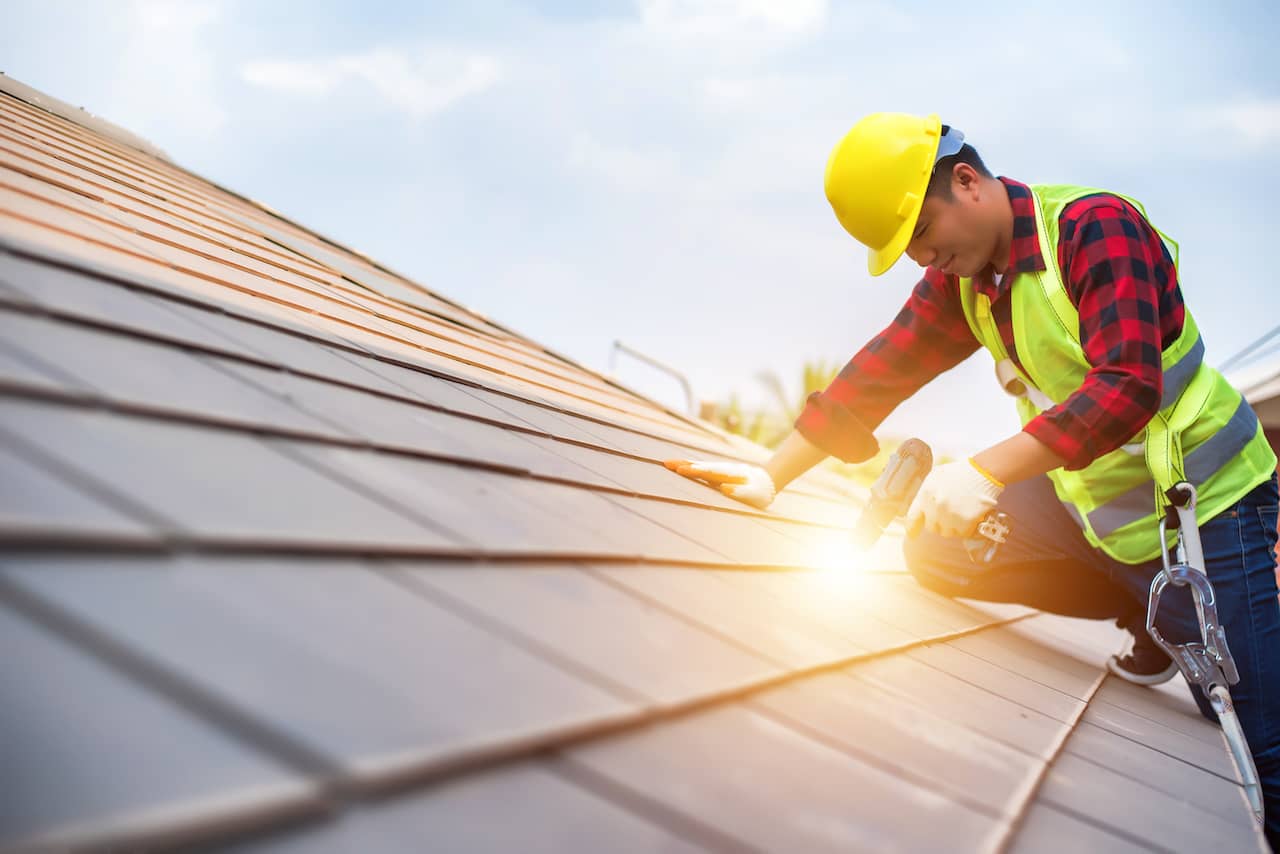Preventative Roofing System Upkeep: Tips to Avoid Costly Repairs
To prevent costly repair work, you ought to check your roofing system on a regular basis for missing out on or harmed tiles, clean your downspouts and seamless gutters to protect against obstructions, and trim overhanging branches. These simple actions can significantly expand your roof's life-span, and there's lots more you can do to secure your financial investment.
Evaluate Your Roofing System Consistently
When you check your roofing system on a regular basis, you can catch prospective concerns prior to they come to be costly repair services. Start by checking for missing out on, fractured, or crinkling tiles; these are indicators that your roofing system may require attention. Seek any type of visible wear around chimneys, vents, and flashing, as these areas are frequently susceptible to leaks. Pay focus to any drooping or unequal areas, which can suggest architectural problems.
After a tornado, it's necessary to assess your roofing for damage brought on by high winds or heavy particles. Do not forget to inspect the bottom of your roofing in the attic room; search for indications of wetness or mold, which can show leaks. You should additionally watch out for granules in your rain gutters, as they can indicate tile deterioration. By taking these actions, you'll lengthen your roofing's lifespan and conserve on your own from unforeseen expenditures. Routine examinations are crucial to preserving a healthy roof.
Clean Rain Gutters and Downspouts
Normal roof covering examinations normally cause a crucial job: cleansing your gutters and downspouts. Clogged up gutters can cause water to support, resulting in possible roofing system leaks and architectural damages. To avoid these problems, make it a practice to check your seamless gutters a minimum of twice a year, specifically after hefty storms or drop when leaves accumulate.
When you cleanse them, start by removing particles like fallen leaves, twigs, and dirt. You can utilize a scoop or your hands, however keep in mind to wear handwear covers. After getting rid of the debris, purge the seamless gutters with water to guarantee appropriate water drainage. Do not forget to examine downspouts for obstructions. If water isn't moving openly, you might need to use a plumbing professional's serpent or a pipe to remove the blockage.
Address Overhanging Branches
Looming branches can present a severe risk to your roof covering, so it's important to cut them regularly. Not just can they trigger damage during tornados, however they can likewise welcome parasites. Make it a habit to examine for any indicators of wear or damages to maintain your roof in top form.
Trim Routinely
One of the most vital steps in roof covering maintenance is to trim those branches that hang as well close to your home. Regularly cutting back these branches maintains your roofing system clear and decreases the threat of leakages and pests. You do not require to tackle this task alone; employing a professional arborist can ensure secure and effective trimming, protecting your roofing system and enhancing your home's general appearance.
Evaluate for Damage
 roof repair
roof repair
Examine for Damaged or Missing Shingles
It's necessary to check your shingles regularly for any kind of damage or missing out on pieces. Change missing out on tiles quickly to protect against additional issues if you detect any kind of concerns. Likewise, watch on exactly how the weather condition influences your roof, as severe problems can result in tear and wear.
Inspect Frequently for Damage
On a regular basis inspecting your roofing for damages is vital to keeping its honesty and extending its life-span. Search for indications of wear, such as fractured, curled, or missing shingles. If left unaddressed, even little concerns can lead to significant troubles. Focus on areas where particles gathers, as this can trap moisture and accelerate damage. Examine your roofing system after heavy storms or strong winds, as these conditions can dislodge or harm shingles. Don't fail to remember to check the flashing around smokeshafts and vents; if it's compromised, it can lead to leakages. By making roofing examinations a routine component of your maintenance regimen, you can catch problems early and conserve yourself from costly repairs down the line. Your roofing will thank you!
Replace Missing Out On Tiles Quickly
After examining for any damage during your evaluations, you may locate that some roof shingles are missing or endangered. Do not wait to replace them; punctual activity can protect against additional problems. Missing tiles reveal your roof to moisture, which can cause leaks and even more extensive damage with time.
Make sure to use shingles that match your roofing system's color and design for a smooth appearance. Maintaining your roofing in leading form is necessary for securing your home and preventing pricey repair services down the line.
Display Weather Impact Regularly
As tornados roll via your area, keeping a close eye on your roofing system comes to be necessary. After each storm, take a moment to inspect your roof for any harmed or missing shingles. Seek granules in your gutters, which can indicate deterioration. If you find any kind of shingles that are cracked, crinkled, or totally gone, address the concern immediately to avoid water leakages and further damages. Climbing onto the roofing system isn't constantly necessary; you can often find problems from the ground with binoculars. Do not fail to remember to look for debris accumulation, as it can trap dampness and result in rot. Routine tracking helps you catch little issues before they intensify, conserving you time and cash in the future.
 roof repair
roof repairMake Sure Appropriate Air Flow
While many homeowners concentrate on the outside and architectural aspects of their roofings, ensuring appropriate ventilation is necessary for preserving its longevity and performance. Poor air flow can lead to warmth accumulation and wetness build-up, which can create damages over time.
Inspect your vents on a regular basis to assure they're not blocked by insulation or particles. It could show insufficient ventilation if you observe any type of signs of mold and mildew or mold. Additionally, think about making use of a powered ventilator if your home has problem with airflow. Correct air flow not just enhances your roofing's lifespan yet also improves energy performance, keeping your home comfortable year-round. By taking these actions, you're spending in your roofing system's wellness and staying clear of expensive repair work down the line.
Seek Indicators of Leaks
Proper air flow assists protect against dampness buildup, yet even with excellent airflow, it is necessary to watch out for signs of leakages. Start by checking your ceilings and wall surfaces for water stains or discoloration, which can suggest a leakage over. Do not forget to check your attic room for damp spots, mold and mildew, or mildew, as these can be very early warning indicators. Search for peeling paint or gurgling wallpaper, as well; these typically signal moisture invasion.
Outside, analyze your roof for missing out on tiles, splits, or damaged blinking, as these susceptabilities can lead to leakages. Routinely inspecting for these signs will certainly aid keep your roof covering's integrity and maintain your home secure and completely dry.
Arrange Specialist Examinations
 roof repair
roof repair
Go for at least one assessment per year, ideally in the spring or fall, to line up with seasonal changes. Throughout these assessments, professionals can identify possible risks like missing out on tiles, deteriorated flashing, or indicators of mold and mildew. They'll also look for particles build-up that could bring about water merging.
Don't wait on visible indications of difficulty; taking positive actions can extend your roofing system's life expectancy. Spending in routine examinations not only shields your home however additionally provides you assurance knowing your roof remains in good condition.
Regularly Asked Inquiries
How Often Should I Carry Out Roofing Inspections?
You ought to execute roofing examinations at the very least two times a year, preferably in springtime and autumn. Regular checks assist you spot possible concerns early, saving you money and time on expensive fixings down the line.
What Tools Do I Need for Roofing System Upkeep?
For roof maintenance, you'll need a tough ladder, safety and security harness, roof nails, a hammer, an utility blade, caulk, a trowel, and a flashlight. Don't neglect gloves and security goggles to keep on your own secured!
Can I Clean My Roof Myself?
Yes, you can cleanse your roofing on your own. Just ensure you have the right tools, put on safety and security equipment, and adhere to correct strategies. It's essential to be careful to avoid accidents and assure efficient cleansing.
Exactly How Can I Identify Roof Leakages Early?
To determine roof covering leaks early, you'll intend to examine your roof covering on a regular basis. Try to find water spots, mold, or missing out on tiles. Take note after heavy rainfall, and don't wait to inspect the attic room for wet areas.
What Are the Indicators I Need a New Roof Covering?
If you notice curled or missing shingles, consistent leaks, or water discolorations on ceilings,You'll need a brand-new roof covering. In addition, if your roof covering's age exceeds two decades, it's smart to consider substitute quicker as opposed to later on.
To avoid expensive repairs, you need to inspect your roof covering routinely for missing out on or harmed shingles, tidy your downspouts and gutters to protect against obstructions, and trim looming branches. Missing roof shingles expose your roof to dampness, which can lead to leaks and more comprehensive damage over time.
After each tornado, take a minute to inspect your roofing for any kind of damaged or missing out on roof shingles.Outdoors, examine your roofing for missing roof shingles, cracks, or harmed blinking, as these vulnerabilities this resource can lead to leakages.To identify roof covering leakages early, you'll want to evaluate your roofing system frequently.